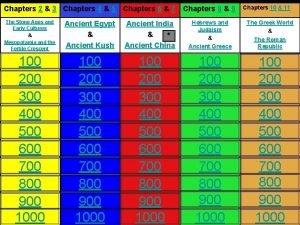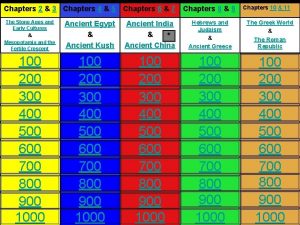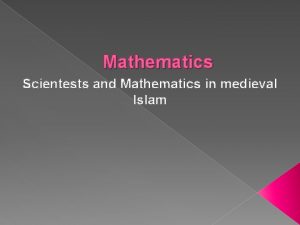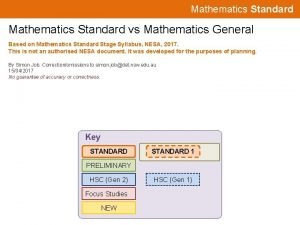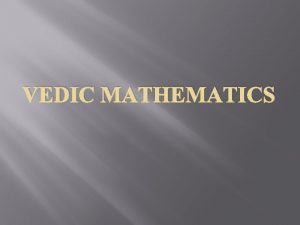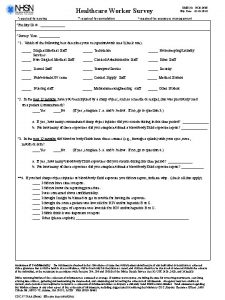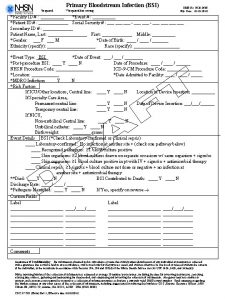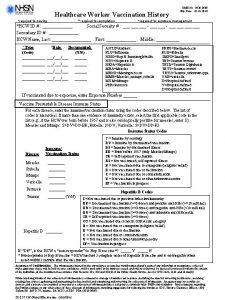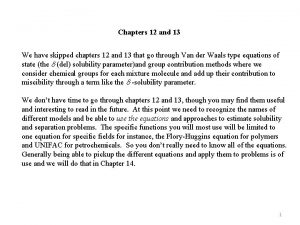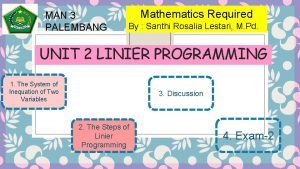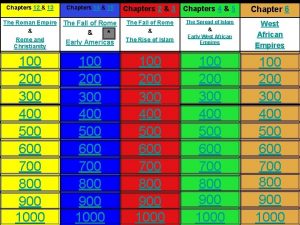Chapters 4 and 8 The Mathematics Required for




































- Slides: 36

Chapters 4 and 8: The Mathematics Required for Public Key Cryptography In case you’re beginning to worry that this is actually a math course, we’ll be skipping the proofs… Fall 2002 CS 395: Computer Security 1

Introduction • A look at finite fields, a concept of increasing importance in cryptography – AES, Elliptic Curve, IDEA, Public Key • concern operations on “numbers” – where what constitutes a “number” and the type of operations varies considerably • start with concepts of groups, rings, fields from abstract algebra Fall 2002 CS 395: Computer Security 2

Group • a set of elements or “numbers” • with some operation whose result is also in the set (closure) • obeys: – associative law: (a. b). c = a. (b. c) – has identity e: e. a = a. e = a – has inverses a-1: a. a-1 = e • if commutative a. b = b. a – then forms an abelian group Fall 2002 CS 395: Computer Security 3

Cyclic Group • define exponentiation as repeated application of operator – example: a-3 = a. a. a • and let identity be: e=a 0 • a group is cyclic if every element is a power of some fixed element – ie b = ak for some a and every b in group • a is said to be a generator of the group Fall 2002 CS 395: Computer Security 4

Ring • a set of “numbers” with two operations (addition and multiplication) which are: • an abelian group with addition operation • multiplication: – has closure – is associative – distributive over addition: a(b+c) = ab + ac • if multiplication operation is commutative, it forms a commutative ring • if multiplication operation has inverses and no zero divisors, it forms an integral domain Fall 2002 CS 395: Computer Security 5

Field • a set of numbers with two operations: – abelian group for addition – abelian group for multiplication (ignoring 0) – Every field is a ring, not vice-versa • Essentially, a field is a set on which we can do addition, subtraction, multiplication, and division without leaving the set. Fall 2002 CS 395: Computer Security 6

Modular Arithmetic • define modulo operator a mod n to be remainder when a is divided by n • use the term congruence for: a ≡ b mod n – when divided by n, a & b have same remainder – eg. 100 = 34 mod 11 • b is called the residue of a mod n – since with integers can always write: a = qn + b • usually have 0 <= b <= n-1 -12 mod 7 ≡ -5 mod 7 ≡ 2 mod 7 ≡ 9 mod 7 Fall 2002 CS 395: Computer Security 7

Modulo 7 Example. . . -21 -20 -19 -18 -17 -16 -15 -14 -13 -12 -11 -10 -9 -8 -7 -6 -5 -4 -3 -2 -1 0 1 2 3 4 5 6 7 8 9 10 11 12 13 14 15 16 17 18 19 20 21 22 23 24 25 26 27 28 29 30 31 32 33 34. . . Fall 2002 CS 395: Computer Security 8

Divisors • say a non-zero number b divides a if for some m have a=mb (a, b, m all integers) • that is b divides into a with no remainder • denote this b|a • and say that b is a divisor of a • eg. all of 1, 2, 3, 4, 6, 8, 12, 24 divide 24 Fall 2002 CS 395: Computer Security 9

Modular Arithmetic Operations • is 'clock arithmetic' • uses a finite number of values, and loops back from either end • modular arithmetic is when do addition & multiplication and modulo reduce answer • can do reduction at any point, I. e. – a+b mod n = [a mod n + b mod n] mod n Fall 2002 CS 395: Computer Security 10

Modular Arithmetic • can do modular arithmetic with any group of integers: Zn = {0, 1, … , n-1} • form a commutative ring for addition • with a multiplicative identity • note some peculiarities – if (a+b)≡(a+c) mod n then b≡c mod n – but (ab)≡(ac) mod n then b≡c mod n only if a is relatively prime to n Fall 2002 CS 395: Computer Security 11

Modulo 8 Example Fall 2002 CS 395: Computer Security 12

Greatest Common Divisor (GCD) • a common problem in number theory • GCD (a, b) of a and b is the largest number that divides evenly into both a and b – eg GCD(60, 24) = 12 • often want no common factors (except 1) and hence numbers are relatively prime – eg GCD(8, 15) = 1 – hence 8 & 15 are relatively prime Fall 2002 CS 395: Computer Security 13

Euclid's GCD Algorithm • an efficient way to find the GCD(a, b) • uses theorem that: – GCD(a, b) = GCD(b, a mod b) • Euclid's Algorithm to compute GCD(a, b): – A=a, B=b – while B>0 • R = A mod B • A = B, B = R – return A Fall 2002 CS 395: Computer Security 14

Example GCD(1970, 1066) A B R 1970 = 1 x 1066 + 904 1066 = 1 x 904 + 162 904 = 5 x 162 + 94 162 = 1 x 94 + 68 94 = 1 x 68 + 26 68 = 2 x 26 + 16 26 = 1 x 16 + 10 16 = 1 x 10 + 6 10 = 1 x 6 + 4 6 = 1 x 4 + 2 4 = 2 x 2 + 0 Fall 2002 gcd(1066, 904) gcd(904, 162) gcd(162, 94) gcd(94, 68) gcd(68, 26) gcd(26, 16) gcd(16, 10) gcd(10, 6) gcd(6, 4) gcd(4, 2) gcd(2, 0) CS 395: Computer Security 15

Chapter 8 – Introduction to Number Theory The Devil said to Daniel Webster: "Set me a task I can't carry out, and I'll give you anything in the world you ask for. " Daniel Webster: "Fair enough. Prove that for n greater than 2, the equation an + bn = cn has no non-trivial solution in the integers. " They agreed on a three-day period for the labor, and the Devil disappeared. At the end of three days, the Devil presented himself, haggard, jumpy, biting his lip. Daniel Webster said to him, "Well, how did you do at my task? Did you prove theorem? ' "Eh? No. . . no, I haven't proved it. " "Then I can have whatever I ask for? Money? The Presidency? ' "What? Oh, that—of course. But listen! If we could just prove the following two lemmas —" —The Mathematical Magpie, Clifton Fadiman Fall 2002 CS 395: Computer Security 16

Prime Numbers • prime numbers only have divisors of 1 and self – they cannot be written as a product of other numbers – note: 1 is prime, but is generally not of interest • eg. 2, 3, 5, 7 are prime, 4, 6, 8, 9, 10 are not • prime numbers are central to number theory • list of prime number less than 200 is: 2 3 5 7 11 13 17 19 23 29 31 37 41 43 47 53 59 61 67 71 73 79 83 89 97 101 103 107 109 113 127 131 137 139 149 151 157 163 167 173 179 181 193 197 199 Fall 2002 CS 395: Computer Security 17

Prime Factorization • to factor a number n is to write it as a product of other numbers: n=a × b × c • note that factoring a number is relatively hard compared to multiplying the factors together to generate the number • the prime factorization of a number n is writing n as a product of primes – eg. 91=7× 13 ; 3600=24× 32× 52 Fall 2002 CS 395: Computer Security 18

Relatively Prime Numbers & GCD • two numbers a, b are relatively prime if have no common divisors apart from 1 – eg. 8 & 15 are relatively prime since factors of 8 are 1, 2, 4, 8 and of 15 are 1, 3, 5, 15 and 1 is the only common factor • conversely can determine the greatest common divisor by comparing their prime factorizations and using least powers – eg. 300=21× 31× 52 18=21× 32 hence GCD(18, 300)=21× 31× 50=6 Fall 2002 CS 395: Computer Security 19

Relatively Prime and the GCD • Theorem: For any nonzero integers a and b, there exist integers s and t such that gcd(a, b) = as + bt. Moreover, gcd(a, b) is the smallest positive integer of the form as + bt. • Proof: (Sorry) Consider the set S, given by Fall 2002 CS 395: Computer Security 20

Proof (cont) • S is obviously nonempty • Well Ordering Principle asserts that S has a smallest element, say d = as + bt. • Claim: d is gcd(a, b). Why? Fall 2002 CS 395: Computer Security 21

Proof (cont. ) Fall 2002 CS 395: Computer Security 22

We’ll Need This Fall 2002 CS 395: Computer Security 23

Bottom Line: d has an inverse modulo n if and only if d and n are relatively prime! Fall 2002 CS 395: Computer Security 24

Fermat's Theorem • ap-1 mod p = 1 – where p is prime and gcd(a, p)=1 • also known as Fermat’s Little Theorem • useful in public key and primality testing Fall 2002 CS 395: Computer Security 25

Euler Totient Function (n) • when doing arithmetic modulo n • complete set of residues is: 0. . n-1 • reduced set of residues is those numbers (residues) which are relatively prime to n – eg for n=10, – complete set of residues is {0, 1, 2, 3, 4, 5, 6, 7, 8, 9} – reduced set of residues is {1, 3, 7, 9} • number of elements in reduced set of residues is called the Euler Totient Function (n) Fall 2002 CS 395: Computer Security 26

Euler Totient Function (n) • to compute (n) need to count number of elements to be excluded • in general need prime factorization, but – for p (p prime) (p) = p-1 – for p. q (p, q prime) (p. q) = (p-1)(q-1) • eg. – (37) = 36 – (21) = (3– 1)×(7– 1) = 2× 6 = 12 Fall 2002 CS 395: Computer Security 27

Euler's Theorem • a generalization of Fermat's Theorem • a (n)mod N = 1 – where gcd(a, N)=1 • eg. – – a=3; n=10; (10)=4; hence 34 = 81 = 1 mod 10 a=2; n=11; (11)=10; hence 210 = 1024 = 1 mod 11 • A Useful corollary: Given two primes, p and q, and integers n=pq and m with 0<m<n, we have Fall 2002 CS 395: Computer Security 28

Primality Testing • often need to find large prime numbers • traditionally sieve using trial division – ie. divide by all numbers (primes) in turn less than the square root of the number – only works for small numbers • alternatively can use statistical primality tests based on properties of primes – for which all primes numbers satisfy property – but some composite numbers, called pseudo-primes, also satisfy the property Fall 2002 CS 395: Computer Security 29

Miller Rabin Algorithm • a test based on Fermat’s Theorem • algorithm is: TEST (n) is: 1. Find integers k, q, k > 0, q odd, so that (n– 1)=2 kq 2. Select a random integer a, 1<a<n– 1 3. if aq mod n = 1 then return (“maybe prime"); 4. for j = 1 to k – 1 do j 5. if (a 2 q mod n = n-1) then return(" maybe prime ") 6. return ("composite") Fall 2002 CS 395: Computer Security 30

Probabilistic Considerations • if Miller-Rabin returns “composite” the number is definitely not prime • otherwise is a prime or a pseudo-prime • chance it detects a pseudo-prime is < ¼ • hence if repeat test with different random a then chance n is prime after t tests is: – Pr(n prime after t tests) = 1 -4 -t – eg. for t=10 this probability is > 0. 99999 Fall 2002 CS 395: Computer Security 31

Prime Distribution • prime number theorem states that primes occur roughly every (ln n) integers • since can immediately ignore evens and multiples of 5, in practice only need test 0. 4 ln(n) numbers of size n before locate a prime – note this is only the “average” sometimes primes are close together, at other times are quite far apart Fall 2002 CS 395: Computer Security 32

Chinese Remainder Theorem • used to speed up modulo computations • working modulo a product of numbers – eg. mod M = m 1 m 2. . mk • Chinese Remainder theorem lets us work in each moduli mi separately • since computational cost is proportional to size, this is faster than working in the full modulus M • Don’t need to read it, just know it helps with some of the computations in RSA public-key scheme Fall 2002 CS 395: Computer Security 33

Primitive Roots • from Euler’s theorem have a (n)mod n=1 • consider ammod n=1, GCD(a, n)=1 – must exist for m= (n) but may be smaller – once powers reach m, cycle will repeat • if smallest is m= (n) then a is called a primitive root • if p is prime, then successive powers of a "generate" the group mod p • these are useful but relatively hard to find Fall 2002 CS 395: Computer Security 34

Discrete Logarithms or Indices • the inverse problem to exponentiation is to find the discrete logarithm of a number modulo p • that is to find x where ax = b mod p • written as x=loga b mod p or x=inda, p(b) • if a is a primitive root then always exists, otherwise may not – x = log 3 4 mod 13 (x st 3 x = 4 mod 13) has no answer – x = log 2 3 mod 13 = 4 by trying successive powers • whilst exponentiation is relatively easy, finding discrete logarithms is generally a hard problem Fall 2002 CS 395: Computer Security 35

Summary • have considered: – – – Fall 2002 prime numbers Fermat’s and Euler’s Theorems Primality Testing Chinese Remainder Theorem Discrete Logarithms CS 395: Computer Security 36
 Formuö
Formuö Novell typiska drag
Novell typiska drag Nationell inriktning för artificiell intelligens
Nationell inriktning för artificiell intelligens Returpilarna
Returpilarna Varför kallas perioden 1918-1939 för mellankrigstiden
Varför kallas perioden 1918-1939 för mellankrigstiden En lathund för arbete med kontinuitetshantering
En lathund för arbete med kontinuitetshantering Särskild löneskatt för pensionskostnader
Särskild löneskatt för pensionskostnader Personlig tidbok
Personlig tidbok A gastrica
A gastrica Vad är densitet
Vad är densitet Datorkunskap för nybörjare
Datorkunskap för nybörjare Tack för att ni lyssnade bild
Tack för att ni lyssnade bild Mall debattartikel
Mall debattartikel Magnetsjukhus
Magnetsjukhus Nyckelkompetenser för livslångt lärande
Nyckelkompetenser för livslångt lärande Påbyggnader för flakfordon
Påbyggnader för flakfordon Arkimedes princip formel
Arkimedes princip formel Publik sektor
Publik sektor Urban torhamn
Urban torhamn Presentera för publik crossboss
Presentera för publik crossboss Teckenspråk minoritetsspråk argument
Teckenspråk minoritetsspråk argument Vem räknas som jude
Vem räknas som jude Treserva lathund
Treserva lathund Mjälthilus
Mjälthilus Bästa kameran för astrofoto
Bästa kameran för astrofoto Cks
Cks Verifikationsplan
Verifikationsplan Bra mat för unga idrottare
Bra mat för unga idrottare Verktyg för automatisering av utbetalningar
Verktyg för automatisering av utbetalningar Rutin för avvikelsehantering
Rutin för avvikelsehantering Smärtskolan kunskap för livet
Smärtskolan kunskap för livet Ministerstyre för och nackdelar
Ministerstyre för och nackdelar Tack för att ni har lyssnat
Tack för att ni har lyssnat Referat mall
Referat mall Redogör för vad psykologi är
Redogör för vad psykologi är Borstål, egenskaper
Borstål, egenskaper Tack för att ni har lyssnat
Tack för att ni har lyssnat





































